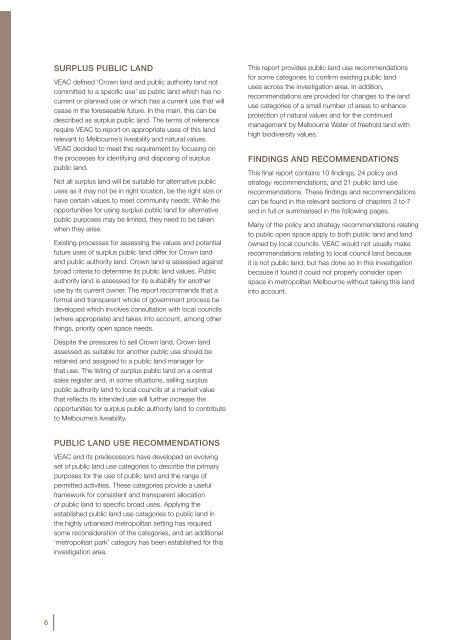Metropolitan Melbourne Investigation - Victorian Environmental ...
Metropolitan Melbourne Investigation - Victorian Environmental ...
Metropolitan Melbourne Investigation - Victorian Environmental ...
You also want an ePaper? Increase the reach of your titles
YUMPU automatically turns print PDFs into web optimized ePapers that Google loves.
SURPLUS PUBLIC LAND<br />
VEAC defined ‘Crown land and public authority land not<br />
committed to a specific use’ as public land which has no<br />
current or planned use or which has a current use that will<br />
cease in the foreseeable future. In the main, this can be<br />
described as surplus public land. The terms of reference<br />
require VEAC to report on appropriate uses of this land<br />
relevant to <strong>Melbourne</strong>’s liveability and natural values.<br />
VEAC decided to meet this requirement by focusing on<br />
the processes for identifying and disposing of surplus<br />
public land.<br />
Not all surplus land will be suitable for alternative public<br />
uses as it may not be in right location, be the right size or<br />
have certain values to meet community needs. While the<br />
opportunities for using surplus public land for alternative<br />
public purposes may be limited, they need to be taken<br />
when they arise.<br />
Existing processes for assessing the values and potential<br />
future uses of surplus public land differ for Crown land<br />
and public authority land. Crown land is assessed against<br />
broad criteria to determine its public land values. Public<br />
authority land is assessed for its suitability for another<br />
use by its current owner. The report recommends that a<br />
formal and transparent whole of government process be<br />
developed which involves consultation with local councils<br />
(where appropriate) and takes into account, among other<br />
things, priority open space needs.<br />
This report provides public land use recommendations<br />
for some categories to confirm existing public land<br />
uses across the investigation area. In addition,<br />
recommendations are provided for changes to the land<br />
use categories of a small number of areas to enhance<br />
protection of natural values and for the continued<br />
management by <strong>Melbourne</strong> Water of freehold land with<br />
high biodiversity values.<br />
FINDINGS AND RECOMMENDATIONS<br />
This final report contains 10 findings, 24 policy and<br />
strategy recommendations, and 21 public land use<br />
recommendations. These findings and recommendations<br />
can be found in the relevant sections of chapters 3 to 7<br />
and in full or summarised in the following pages.<br />
Many of the policy and strategy recommendations relating<br />
to public open space apply to both public land and land<br />
owned by local councils. VEAC would not usually make<br />
recommendations relating to local council land because<br />
it is not public land, but has done so in this investigation<br />
because it found it could not properly consider open<br />
space in metropolitan <strong>Melbourne</strong> without taking this land<br />
into account.<br />
Despite the pressures to sell Crown land, Crown land<br />
assessed as suitable for another public use should be<br />
retained and assigned to a public land manager for<br />
that use. The listing of surplus public land on a central<br />
sales register and, in some situations, selling surplus<br />
public authority land to local councils at a market value<br />
that reflects its intended use will further increase the<br />
opportunities for surplus public authority land to contribute<br />
to <strong>Melbourne</strong>’s liveability.<br />
PUBLIC LAND USE RECOMMENDATIONS<br />
VEAC and its predecessors have developed an evolving<br />
set of public land use categories to describe the primary<br />
purposes for the use of public land and the range of<br />
permitted activities. These categories provide a useful<br />
framework for consistent and transparent allocation<br />
of public land to specific broad uses. Applying the<br />
established public land use categories to public land in<br />
the highly urbanised metropolitan setting has required<br />
some reconsideration of the categories, and an additional<br />
‘metropolitan park’ category has been established for this<br />
investigation area.<br />
6
















